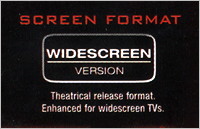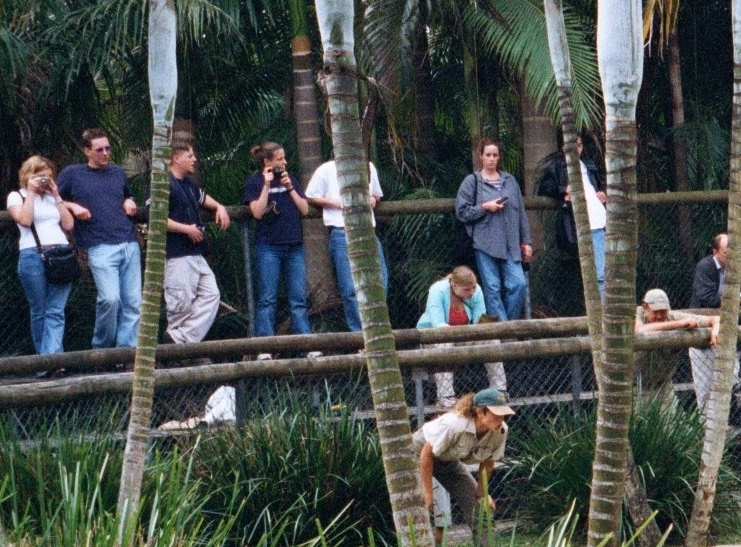|
Windowbox (film)
Windowboxing (also called either the "postage stamp effect", "gutterboxing", "matchboxing", or "double letterboxing") in the display of film or video occurs when the aspect ratio of the media is such that the letterbox effect and pillarbox effect occur simultaneously. Sometimes, by accident or design, a standard ratio image is presented in the central portion of a letterbox picture (or vice versa), resulting in a black border all around. It is generally disliked because it wastes much screen space and reduces the resolution of the original image. It can occur when a 16:9 film is set to 4:3 ( letterbox), but then shown on a 16:9 TV or other output device. It can also occur in the opposite direction (4:3 to 16:9 to 4:3). Few films have been released with this aspect ratio—one example is '' The Crocodile Hunter: Collision Course'', which had numerous scenes with Steve & Terri Irwin using widescreen pillar boxing. Deliberate windowboxing On rare occasion, a picture will ... [...More Info...] [...Related Items...] OR: [Wikipedia] [Google] [Baidu] |
Blu-ray Disc
The Blu-ray Disc (BD), often known simply as Blu-ray, is a digital optical disc data storage format. It was invented and developed in 2005 and released on June 20, 2006 worldwide. It is designed to supersede the DVD format, and capable of storing several hours of high-definition video (HDTV 720p and 1080p). The main application of Blu-ray is as a medium for video material such as feature films and for the physical distribution of video games for the PlayStation 3, PlayStation 4, PlayStation 5, Xbox One, and Xbox Series X. The name "Blu-ray" refers to the blue laser (which is actually a violet laser) used to read the disc, which allows information to be stored at a greater density than is possible with the longer-wavelength red laser used for DVDs. The polycarbonate disc is in diameter and thick, the same size as DVDs and CDs. Conventional or pre-BD-XL Blu-ray Discs contain 25 GB per layer, with dual-layer discs (50 GB) being the industry standard for featu ... [...More Info...] [...Related Items...] OR: [Wikipedia] [Google] [Baidu] |
Anamorphic Widescreen
Anamorphic widescreen (also called Full height anamorphic or FHA) is a process by which a comparatively wide widescreen image is horizontally compressed to fit into a storage medium (photographic film or MPEG-2 standard-definition frame, for example) with a narrower aspect ratio, reducing the horizontal resolution of the image while keeping its full original vertical resolution. Compatible play-back equipment (a projector with modified lens, or a digital video player or set-top box) can then expand the horizontal dimension to show the original widescreen image. This is typically used to allow one to store widescreen images on a medium that was originally intended for a narrower ratio, while using as much of the frame – and therefore recording as much detail – as possible. The technique comes from cinema, when a film would be framed and recorded as widescreen but the picture would be "squashed together" using a special concave lens to fit into non-widescreen 1.37:1 ... [...More Info...] [...Related Items...] OR: [Wikipedia] [Google] [Baidu] |
Overscan
Overscan is a behaviour in certain television sets, in which part of the input picture is shown outside of the visible bounds of the screen. It exists because cathode-ray tube (CRT) television sets from the 1930s through to the early 2000s were highly variable in how the video image was positioned within the borders of the screen. It then became common practice to have video signals with black edges around the picture, which the television was meant to discard in this way. Origins Early analog televisions varied in the displayed image because of manufacturing tolerance problems. There were also effects from the early design limitations of power supplies, whose DC voltage was not regulated as well as in later power supplies. This could cause the image size to change with normal variations in the AC line voltage, as well as a process called blooming, where the image size increased slightly when a brighter overall picture was displayed due to the increased electron beam current ca ... [...More Info...] [...Related Items...] OR: [Wikipedia] [Google] [Baidu] |
Academy Ratio
The Academy ratio of 1.375:1 (abbreviated as 1.37:1) is an aspect ratio of a frame of 35 mm film when used with 4-perf pulldown.Monaco, James. ''How to Read a Film: The Art, Technology, Language, History and Theory of Film and Media''. Rev. ed. New York: Oxford University Press, 1981. .Bordwell, David and Thompson, Kristin. ''Film Art: An Introduction''. Rev. ed. New York: McGraw-Hill, 1993. . It was standardized by the Academy of Motion Picture Arts and Sciences as the standard film aspect ratio in 1932, although similar-sized ratios were used as early as 1928. History Silent films were shot at a 1. aspect ratio (also known as a 4:3 aspect ratio), with each frame using all of the negative space between the two rows of film perforations for a length of 4 perforations. The frame line between the silent film frames was very thin. When sound-on-film was introduced in the late 1920s, the soundtrack was recorded in a stripe running just inside one set of the perforations a ... [...More Info...] [...Related Items...] OR: [Wikipedia] [Google] [Baidu] |
Stereoscopy
Stereoscopy (also called stereoscopics, or stereo imaging) is a technique for creating or enhancing the illusion of depth in an image by means of stereopsis for binocular vision. The word ''stereoscopy'' derives . Any stereoscopic image is called a stereogram. Originally, stereogram referred to a pair of stereo images which could be viewed using a stereoscope. Most stereoscopic methods present a pair of two-dimensional images to the viewer. The left image is presented to the left eye and the right image is presented to the right eye. When viewed, the human brain perceives the images as a single 3D view, giving the viewer the perception of 3D depth. However, the 3D effect lacks proper focal depth, which gives rise to the Vergence-Accommodation Conflict. Stereoscopy is distinguished from other types of 3D displays that display an image in three full dimensions, allowing the observer to increase information about the 3-dimensional objects being displayed by head and eye ... [...More Info...] [...Related Items...] OR: [Wikipedia] [Google] [Baidu] |
3D Film
3D films are motion pictures made to give an illusion of three-dimensional solidity, usually with the help of special glasses worn by viewers. They have existed in some form since 1915, but had been largely relegated to a niche in the motion picture industry because of the costly hardware and processes required to produce and display a 3D film, and the lack of a standardized format for all segments of the entertainment business. Nonetheless, 3D films were prominently featured in the 1950s in American cinema, and later experienced a worldwide resurgence in the 1980s and 1990s driven by IMAX high-end theaters and Disney-themed venues. 3D films became increasingly successful throughout the 2000s, peaking with the success of 3D presentations of ''Avatar'' in December 2009, after which 3D films again decreased in popularity. Certain directors have also taken more experimental approaches to 3D filmmaking, most notably celebrated auteur Jean-Luc Godard in his film ''Goodbye to Language' ... [...More Info...] [...Related Items...] OR: [Wikipedia] [Google] [Baidu] |
Brother Bear
''Brother Bear'' is a 2003 American animated musical fantasy comedy-drama film produced by Walt Disney Feature Animation and released by Walt Disney Pictures. The 44th Disney animated feature film, it was directed by Aaron Blaise and Robert Walker (in their feature directorial debuts) and produced by Chuck Williams, from a screenplay written by Tab Murphy, Lorne Cameron, David Hoselton, and the writing team of Steve Bencich and Ron J. Friedman. The film stars the voices of Joaquin Phoenix, Jeremy Suarez, Rick Moranis, Dave Thomas, Jason Raize, and D.B. Sweeney. ''Brother Bear'' follows an Alaska native boy named Kenai as he pursues a bear and kills it, but the Spirits, incensed by this unnecessary death, change Kenai into a bear himself as punishment. In order to be human again, Kenai must travel to a mountain where the Northern lights touch the earth. The film was the third and final Disney animated feature produced primarily by the Feature Animation studio at Disney-M ... [...More Info...] [...Related Items...] OR: [Wikipedia] [Google] [Baidu] |
Rent (film)
''Rent'' is a 2005 American musical drama film directed by Chris Columbus. It is an adaptation of the 1996 Broadway musical of the same name, in turn based on Giacomo Puccini's 1896 opera ''La bohème''. The film, which features six of the original Broadway cast members reprising their roles, depicts the lives of several bohemians and their struggles with sexuality, drugs, paying their rent, and life under the shadow of AIDS in the gritty East Village of New York City from 1989 to 1990. Plot On Christmas Eve 1989, aspiring filmmaker Mark Cohen, and his roommate, Roger Davis, learn that the rent previously waived by their old friend and now landlord, Benjamin "Benny" Coffin III, is due ("Rent"). Their former roommate Tom Collins shows up and gets mugged. Mark and Roger meet with Benny, who tells them he plans to evict the homeless from the nearby lot and build a cyber studio ("You'll See"). He offers them free rent if they get Maureen, Mark's ex-girlfriend, to cancel her ... [...More Info...] [...Related Items...] OR: [Wikipedia] [Google] [Baidu] |
Aspect Ratio (image)
The aspect ratio of an image is the ratio of its width to its height, and is expressed with two numbers separated by a colon, such as ''16:9'', sixteen-to-nine. For the ''x'':''y'' aspect ratio, the image is ''x'' units wide and ''y'' units high. Common aspect ratios are 1.85:1 and 2.39:1 in cinematography, 4:3 and 16:9 in television photography, and 3:2 in still photography. Some common examples The common film aspect ratios used in cinemas are 1.85:1 and 2.39:1.The 2.39:1 ratio is commonly labeled 2.40:1, e.g., in the American Society of Cinematographers' ''American Cinematographer Manual'' (Many widescreen films before the 1970 SMPTE revision used 2.35:1). Two common videographic aspect ratios are 4:3 (1.:1), the universal video format of the 20th century, and 16:9 (1.:1), universal for high-definition television and European digital television. Other cinema and video aspect ratios exist, but are used infrequently. In still camera photography, the most common aspect ... [...More Info...] [...Related Items...] OR: [Wikipedia] [Google] [Baidu] |
Terri Irwin
Terri Raines Irwin (née Raines, born July 20, 1964) is an American-Australian conservationist, television personality and author who is the owner of Australia Zoo in Beerwah, Queensland. She is the widow of Steve Irwin. Born in Oregon, she began working for an independent animal rehabilitation center for injured predator mammals at the age of 22 while working for her family's trucking business. While touring wildlife rehabilitation facilities in Australia in 1991, she had a chance meeting with Irwin. The two married in 1992, and went on to co-star in ''The Crocodile Hunter'', their unconventional television nature documentary series and its spin-off series, ''Croc Files'', ''The Crocodile Hunter Diaries'', and '' Crikey! It's the Irwins''. They had two children, Bindi and Robert, before Steve's death in 2006 from a stingray injury. Following Steve's death, Terri became a naturalised Australian citizen in 2009. She and her two children continue to operate Australia Zoo. Ea ... [...More Info...] [...Related Items...] OR: [Wikipedia] [Google] [Baidu] |




